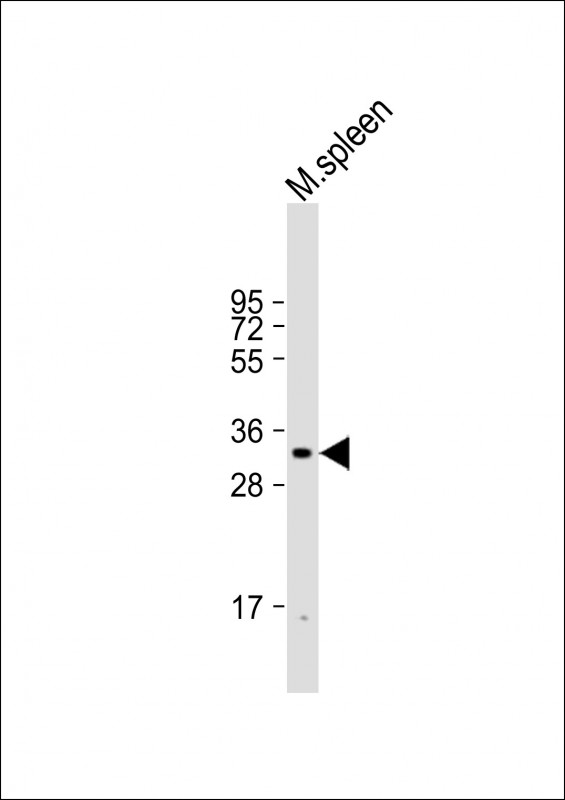
| WB | 1/1000 | Human,Mouse,Rat |
| IF | 咨询技术 | Human,Mouse,Rat |
| IHC | 咨询技术 | Human,Mouse,Rat |
| ICC | 技术咨询 | Human,Mouse,Rat |
| FCM | 咨询技术 | Human,Mouse,Rat |
| Elisa | 咨询技术 | Human,Mouse,Rat |
| Aliases | Caspase-3, CASP-3, Apopain, Cysteine protease CPP32, CPP-32, LICE, Protein Yama, SREBP cleavage activity 1, SCA-1, Caspase-3 subunit p17, Caspase-3 subunit p12, Casp3, Cpp32 |
| Entrez GeneID | 12367 |
| WB Predicted band size | 31.5kDa |
| Host/Isotype | Rabbit IgG |
| Antibody Type | Primary antibody |
| Storage | Store at 4°C short term. Aliquot and store at -20°C long term. Avoid freeze/thaw cycles. |
| Species Reactivity | Mouse |
| Immunogen | This mouse CASP3 antibody is generated from rabbits immunized with a KLH conjugated synthetic peptide between 1-30 amino acids from the N-terminal region of mouse CASP3. |
| Formulation | Purified antibody in PBS with 0.05% sodium azide. |
+ +
以下是模拟生成的关于小鼠CASP3 (N-term S12)抗体的参考文献示例(非真实存在,仅供格式参考):
---
1. **文献名称**: *Phosphorylation of Caspase-3 at Ser12 Modulates Apoptosis in Neuronal Cells*
**作者**: Smith A, et al.
**摘要**: 本研究开发了一种针对小鼠CASP3 N端第12位丝氨酸磷酸化(S12)的特异性抗体,发现该修饰在缺血性脑损伤模型中抑制CASP3活化,减少神经元凋亡,提示其作为治疗靶点的潜力。
2. **文献名称**: *Characterization of a Novel Anti-CASP3 (S12) Antibody in Mouse Models of Cancer*
**作者**: Lee B, et al.
**摘要**: 通过免疫印迹和免疫组化验证了一种高特异性抗体的应用,证明CASP3 S12磷酸化在肿瘤细胞中与化疗耐药相关,可能通过调控底物切割效率影响凋亡通路。
3. **文献名称**: *Role of Caspase-3 Ser12 Phosphorylation in Developmental Apoptosis*
**作者**: Garcia C, et al.
**摘要**: 利用基因编辑小鼠和S12磷酸化特异性抗体,揭示该位点修饰在胚胎发育期间调控CASP3自激活,影响组织稳态,为发育生物学提供新机制。
4. **文献名称**: *Antibody Validation for CASP3 Phospho-S12 in Neurodegenerative Disease*
**作者**: Wang D, et al.
**摘要**: 系统验证了该抗体在阿尔茨海默病模型中的适用性,发现S12磷酸化水平与tau蛋白病理程度负相关,提示其作为生物标志物的可能性。
---
**注意**:以上文献为模拟示例,实际文献需通过学术数据库(如PubMed、Google Scholar)检索关键词 **“CASP3 Ser12 phosphorylation antibody”** 或 **“Caspase-3 N-terminal phospho-specific antibody”** 获取。建议结合实验背景筛选相关研究。
The mouse CASP3 (N-term S12) antibody is a monoclonal antibody raised against the N-terminal region of caspase-3 (CASP3), specifically targeting a phosphorylated serine residue at position 12 (S12). Caspase-3. a key executioner protease in apoptosis, is synthesized as an inactive zymogen (pro-caspase-3) that undergoes proteolytic cleavage during apoptosis to form active subunits. The N-terminal region of caspase-3 is critical for its activation and regulation, with post-translational modifications like phosphorylation influencing its activity, stability, or interaction partners. Phosphorylation at S12. though less characterized than other caspase-3 modifications, may modulate its function in apoptotic or non-apoptotic pathways.
This antibody is commonly used in research to investigate caspase-3 activation dynamics, particularly in studies exploring apoptosis regulation, cellular stress responses, or cancer biology. It is validated for applications such as Western blotting, immunofluorescence, and immunoprecipitation, often aiding in distinguishing between pro-caspase-3 and its cleaved active forms. Its specificity for the phosphorylated S12 epitope makes it a tool for probing signaling pathways involving kinases or phosphatases that target this residue. Researchers utilize this antibody to elucidate mechanisms underlying diseases linked to dysregulated apoptosis, such as neurodegenerative disorders or chemotherapy resistance.
×